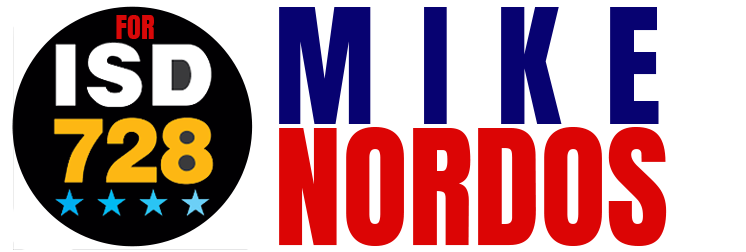ENSURING FUTURE SUCCESS
We must return to proven academic basics without political influences.
When the 5-year ISD 728 strategic plan was implemented in 2023, there were no specific, measurable goals included for academic improvement for students. In a time when Minnesota schools are failing their students and test scores at are an all-time historical low, it is imperative that districts implement specific academic goals that are measured regularly with plans for improvement if not met.
When the 5-year ISD 728 strategic plan was implemented in 2023, there were no specific, measurable goals included for academic improvement for students. In a time when Minnesota schools are failing their students and test scores at are an all-time historical low, it is imperative that districts implement specific academic goals that are measured regularly with plans for improvement if not met.
As a candidate, I propose rehashing the 2023 5-year strategic plan to incorporate specific academic goals by subject and grade level including specific tools to be implemented that improve success. This task will include partnering with educators, paras, and other front-line staff to evaluate best strategies that produce proven results and continued measurement of outcomes with agreed upon strategies to change course if measurable goals are not met.
The purpose of the public education system is to academically prepare students to either successfully enter the workforce and/or be well prepared to continue their education at a higher level. Without measurable goals that are shared with the community, we have no way of determining if the school district is appropriately serving its students. The community must elect school board members dedicated to real academic success and a willingness to change course when metrics aren’t met.
One potential idea to positively impact academic achievement is reducing classroom size at critical periods of learning. For example, children learn reading fundamentals in very early grades. Research shows that class size can drive student success in these areas. Again, solutions ought to require partnership with educators, administration, and board members to best determine a path forward to improving reading in the district. One possible solution is to implement a small classroom pilot program across several schools in the early grades to track student outcomes and improvement and to test this theory. Further, smaller class sizes in key grades may reduce teacher stress and staff turnover. See links to academic studies below that link class size to academic outcomes.
https://repository.stcloudstate.edu/cgi/viewcontent.cgi?article=1053&context=ed_etds
https://deepblue.lib.umich.edu/bitstream/handle/2027.42/117901/Ruggles.pdf
While the Elk River district outperforms most other districts in MN, it is important to look at the details and understand in a state-wide system that is generally failing its students, it is easy to compete and appear as though the district is producing excellent results. Following are actual data for reading proficiency in our district that is telling.
Vision
Empowering every student to excel academically, preparing them with a strong foundation in fundamental subjects and critical thinking skills, ensuring they are equipped to succeed in their academic pursuits and contribute meaningfully to society.
Mission
To provide a rigorous and comprehensive education that emphasizes academic excellence, instills a deep understanding of core subjects, and fosters critical thinking skills, preparing students for success in higher education, the workforce, and beyond.
Goals
Academic Excellence:
· Increase the percentage of students achieving proficiency or above in core subjects by 10% over five years, as measured by standardized assessments.
· Assess achievement gaps and identify barriers.
Graduation Rates and College Readiness:
· Increase the overall high school graduation rate by 5% over five years.
· Increase the percentage of graduates enrolling in post-secondary education or entering the workforce with relevant skills by 15% over five years.
Safe School environment:
· Ensure the safety and security of students and staff by implementing robust safety protocols, emergency preparedness measures, and proactive measures to prevent bullying, harassment, and violence.
· Empower and equip staff with effective disciplinary tools to maintain a safe and orderly learning environment, ensuring that consequences for misconduct are clear, consistent, and conducive to maintaining discipline and respect for all members of the school community.
· Implement comprehensive workplace safety protocols and training programs to reduce the incidence of accidents and violence, ensuring the physical and emotional well-being of all staff members.
Curriculum:
· Implement a district-wide STEM focused curriculum and provide professional development opportunities for STEM teachers to enhance student engagement and achievement.
· Increase the percentage of students reading at or above grade level by 5% over five years through targeted literacy intervention programs and early literacy initiatives.
· Increase the percentage of students meeting grade level proficiency in math by 5% over 5 years.
Strategies
Data-Driven Decision Making:
· Establish a data analytics team to collect, analyze, and utilize student performance data to inform instructional practices, intervention strategies, and resource allocation.
Professional Development:
· Provide targeted professional development opportunities for teachers and staff focused on enhancing instructional excellence, traditional teaching methodologies, and subject-matter expertise, ensuring educators are equipped with the knowledge and skills necessary to deliver rigorous and effective instruction in core academic subjects
Community Engagement:
· Foster partnerships with parents, community organizations, local businesses, and higher education institutions to provide additional resources, mentorship opportunities, and support services for students.
· Implement community advisory boards to guide board policy development.
· Ensure all board meetings are recorded and accessible. Including public comments to the board.
Continuous Improvement:
· Establish regular monitoring and evaluation processes to assess progress towards goals, identify areas for improvement, and adjust strategies as needed.
Measurable Outcomes
· Percentage of students achieving proficiency or above in core subjects.
· High school graduation rates and college enrollment rates.
· Reduction in disciplinary incidents and achievement gaps.
· Participation and performance of students in advanced coursework.
· Improvement in literacy rates and STEM proficiency.
· Reduction in incidents of bullying and improvement in student well-being.
· Increase in staff retention rates.
· Reduction in workplace injury reports.
- Westwood Elementary, Zimmerman: only 50.9% of 3rd graders were proficient in reading.
- Otsego Elementary, Otsego: only 60.9% of 3rd graders were proficient in reading.
- Meadowvale Elementary, Elk River: only 62.7% of 3rd graders were proficient in reading.
- Parker Elementary, Elk River: only 62.6% of 3rd graders were proficient in reading.
Source: https://www.schoooldigger.com/go/MN/district/11370/search.aspx



